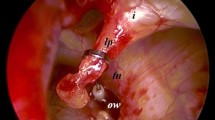Abstract
Purpose of Review
Stapes surgery is challenging yet rewarding hearing restoration procedure. Endoscopic ear surgery is a relatively new technique for managing otologic pathology. Stapes surgery presents a unique challenge when performed via a transcanal endoscopic approach because the surgeon is confined to using one hand for management of the footplate and placing the prosthesis.
Recent Findings
Outcomes have been published for endoscopic stapes surgery, with several studies comparing endoscopic with the traditional microscopic approach. Several authors noted the need for less bone removal and less pain after endoscopic stapes surgery. Complication rates following stapes surgery did not seem to differ whether the endoscope or the microscope was used. Nonetheless, the overall audiometric results appear to be equivalent.
Summary
Endoscopic stapes surgery has several potential benefits including visualizing unique anatomic variants, improved visualization of the anterior crus, the need for less bone removal in the setting of malleus fixation, and to date equivalent hearing outcomes.
Similar content being viewed by others
References
Papers of particular interest, published recently, have been highlighted as: • Of importance •• Of major importance
Tarabichi M. Endoscopic middle ear surgery. Ann Otol Rhinol Laryngol. 1999;108:39–46.
Bennett ML, Zhang D, Labadie RF, Noble JH. Comparison of middle ear visualization with endoscopy and microscopy. Otol Neurotol. 2016;37:362–6.
• Nassiri AM, Yawn RJ, Dedmon MM, et al. Primary endoscopic stapes surgery: audiologic and surgical outcomes. Otol Neurotol. 2018;39:1095–101. Findings from this study demonstrate equivalent audiologic outcomes when comparing endoscopic stapedectomy to stapedotomy.
•• Hall AC, Mandavia R, Selvadurai D. Total endoscopic stapes surgery: systematic review and pooled analysis of audiological outcomes. Laryngoscope. 2019. Hall’s systematic review and pooled analysis study of 314 patients undergoing endoscopic stapes surgery demonstrated hearing outcomes and complications rates similar to microscopic stapes surgery.
Fernandez IJ, Villari D, Botti C, Presutti L. Endoscopic revision stapes surgery: surgical findings and outcomes. Eur Arch Otorhinolaryngol. 2019;276:703–10.
•• Nikolaos T, Aikaterini T, Dimitrios D, et al. Does endoscopic stapedotomy increase hearing restoration rates comparing to microscopic? A systematic review and meta-analysis. Eur Arch Otorhinolaryngol. 2018;275:2905–13. This systematic review and meta-analysis demonstrated no difference in hearing outcomes between microscopic and endoscopic stapes surgery, but did demonstrate the need for less scutum removal and a lower incidence of dysgeusia.
Isaacson B, Wick CC, Hunter JB. Endoscopic ossiculoplasty. Oper Tech Otolaryngol. 2017;28:39–43.
Hong RS, Metz CM, Bojrab DI, et al. Acoustic reflex screening of conductive hearing loss for third window disorders. Otolaryngol Head Neck Surg. 2016;154:343–8.
Stevens JR, Pfannenstiel TJ. The otologist’s tuning fork examination--are you striking it correctly? Otolaryngol Head Neck Surg. 2015;152:477–9.
Lee JK, Cho YS, Ko MH, et al. Video pneumatic otoscopy for the diagnosis of conductive hearing loss with normal tympanic membranes. Otolaryngol Head Neck Surg. 2011;144:67–72.
Nguyen T, Pulickal G, Singh A, Lingam R. Conductive hearing loss with a “dry middle ear cleft”-a comprehensive pictorial review with CT. Eur J Radiol. 2019;110:74–80.
Cushing SL, Papsin BC. The top 10 considerations in pediatric ossiculoplasty. Otolaryngol Head Neck Surg. 2011;144:486–90.
Badr-El-Dine M, James AL, Panetti G, Marchioni D, Presutti L, Nogueira JF. Instrumentation and technologies in endoscopic ear surgery. Otolaryngol Clin N Am. 2013;46:211–25.
Kozin ED, Lehmann A, Carter M, et al. Thermal effects of endoscopy in a human temporal bone model: implications for endoscopic ear surgery. Laryngoscope. 2014;124:E332–9.
McCallum R, McColl J, Iyer A. The effect of light intensity on image quality in endoscopic ear surgery. Clin Otolaryngol. 2018;43:1266–72.
Isaacson B, Hunter JB, Rivas A. Endoscopic stapes surgery. Otolaryngol Clin N Am. 2018;51:415–28.
Zhu VF, Kou YF, Lee KH, Kutz JW Jr, Isaacson B. Transcanal endoscopic ear surgery for the management of congenital ossicular fixation. Otol Neurotol. 2016;37:1071–6.
Nassiri AM, Yawn RJ, Dedmon MM, et al. Audiologic and surgical outcomes in endoscopic revision stapes surgery. Laryngoscope. 2019;129:2366–70.
• Tolisano AM, Fontenot MR, Nassiri AM, et al. Pediatric stapes surgery: hearing and surgical outcomes in endoscopic vs microscopic approaches. Otolaryngol Head Neck Surg. 2019;161:150–6. Tolisano et al. published the largest series of pediatric stapes surgery comparing endoscopic and microscopic techniques. Audiometric outcomes and complication rates were similar between the two groups.
Author information
Authors and Affiliations
Corresponding author
Ethics declarations
The Institutional Review Board waived this study for review.
Conflict of Interest
Brandon Isaacson is a consultant for Advanced Bionics, Olympus, Medtronic, Storz, and Stryker. Jacob B. Hunter reports other from Advanced Bionics, MED-EL, Oticon, and Medtronic. All other authors declare that they have no conflicts of interest.
Human and Animal Rights and Informed Consent
This article does not contain any studies with human or animal subjects performed by any of the authors.
Additional information
This manuscript is original and it, or any part of it, has not been previously published, nor is it under consideration for publication elsewhere.
Publisher’s Note
Springer Nature remains neutral with regard to jurisdictional claims in published maps and institutional affiliations.
This article is part of the Topical Collection on Ossicular Chain Reconstruction
Electronic Supplementary Material
Video 1
This video demonstrates transcanal endoscopic ear surgery for the management of congenital footplate fixation. A diode laser is used to transect the crura while a microdrill and oval window rasp are used to perform a partial stapedectomy. Perichondrium is used to seal the oval window and a titanium notched bucket handle prosthesis is used to reconstruct the ossicular chain (MOV 3.02 gb)
Rights and permissions
About this article
Cite this article
Isaacson, B., Lee, K.H., Walter Kutz, J. et al. Endoscopic Stapes Surgery. Curr Otorhinolaryngol Rep 8, 79–82 (2020). https://doi.org/10.1007/s40136-020-00266-x
Published:
Issue Date:
DOI: https://doi.org/10.1007/s40136-020-00266-x




